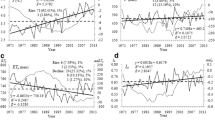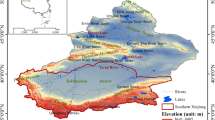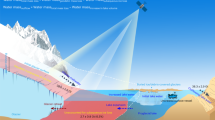Abstract
Lake expansion since the middle of the 1990s is one of the most outstanding environmental change events in the Tibetan Plateau (TP). This expansion has mainly occurred in the Inner TP, a vast endorheic basin with an area of about 708,000 km2 and containing about 780 lakes larger than 1 km2. The total lake area of the Inner TP has increased from 24,930 km2 in 1995 to 33,741 km2 in 2015. The variability of the lake area in the coming decades is crucial for infrastructure planning and ecology policy for this remote region. In this study, a lake mass balance model was developed to describe the lake area response to climate change. First, the model was used to inversely estimate the change in precipitation from the change in lake volume. The result shows that precipitation has increased by about 21 ± 7% since the middle of the 1990s, as seen in GPCC global data set. Then, the lake size in the coming two decades was predicted by the model driven with either current climate or a projected future climate, showing the lake area would expand continuously, but at a lower rate than before. Both predictions yield a total lake area of 36150 ± 500 km2 in 2025 and a rise of average lake level by about 6.6 ± 0.3 m from 1995 to 2025. However, the two predictions become disparate in the second decade (2026–2035), as the future climate is more warming and wetting than the current climate. It is noted that the prediction of lake expansion is robust for the entire inner TP lake system but not always applicable to individual subregions or specific lakes due to their spatiotemporal heterogeneity.






Similar content being viewed by others
References
Adler RF et al (2003) The version-2 global precipitation climatology project (GPCP) monthly precipitation analysis (1979–present). J Hydrometeorol 4:1147–1167
Ashouri H, Hsu KL, Sorooshian S et al (2015) PERSIANN-CDR: daily precipitation climate data record from multisatellite observations for hydrological and climate studies. Bull Am Meteorol Soc 96:69–83
Biskop S, Maussion F, Krause P, Fink M (2016) Differences in the water-balance components of four lakes in the southern-central Tibetan Plateau. Hydrol Earth Syst Sci 20:209–225
Bracht-Flyr B, Istanbulluoglu E, Fritz S (2013) A hydro-climatological lake classification model and its evaluation using global data. J Hydrol 486:376–383
Brun F, Berthier E, Wagnon P, Kääb A, Treichler D (2017) A spatially resolved estimate of High Mountain Asia glacier mass balances from 2000 to 2016. Nat Geosci. https://doi.org/10.1038/ngeo2999
Budyko MI (1958) The heat balance of the Earth’s surface, p 144–155, Natl. Weather Serv., U. S. Dep. of Commer., Washington, D.C
Crétaux JF et al (2011) SOLS: a lake database to monitor in the Near Real Time water level and storage variations from remote sensing data. Adv Space Res 47:1497–1507
Crétaux JF, Abarca-del-Río R, Bergé-Nguyen M et al (2016) Lake volume monitoring from space. Surv Geophys 37:269–305
Fu BP (1981) On the calculation of the evaporation from land surface (in Chinese). Sci Atmos Sin 5(1):23–31
Gardner AS et al (2013) A reconciled estimate of glacier contributions to sea level rise: 2003 to 2009. Science 340(6134):852–857
Guo Y, Zhang Y, Ma N, Song H, Gao H (2016) Quantifying surface energy fluxes and evaporation over a significant expanding endorheic lake in the central Tibetan Plateau. J Meteorol Soc Jpn Ser II 94:453–465
Hempel S, Frieler K, Warszawski L, Schewe J, Piontek F (2013) A trend-preserving bias correction—the ISI-MIP approach. Earth Syst Dynam 4(2):219–236. https://doi.org/10.5194/esd-4-219-2013
Hwang C, Peng MF, Ning J, Luo J, Sui CH (2005) Lake level variations in China from TOPEX/Poseidon altimetry: data quality assessment and links to precipitation and ENSO. Geophys J Int 161:1–11
Jiang L, Nielsen K, Andersen OB, Bauer-Gottwein P (2017) Monitoring recent lake level variations on the Tibetan Plateau using CryoSat-2 SARIn mode data. J Hydrol 544:109–124
Kleinherenbrink M, Lindenbergh RC, Ditmar PG (2015) Monitoring of lake level changes on the Tibetan Plateau and Tian Shan by retracking Cryosat SARIn waveforms. J Hydrol 521:119–131
Lazhu, Yang K, Wang J et al (2016) Quantifying evaporation and its decadal change for Lake Nam Co, central Tibetan Plateau. J Geophys Res: Atmos 121:7578–7591
Lei Y, Yao T, Bird BW et al (2013) Coherent lake growth on the central Tibetan Plateau since the 1970s: characterization and attribution. J Hydrol 483:61–67
Lei Y, Yang K, Wang B et al (2014) Response of inland lake dynamics over the Tibetan Plateau to climate change. Clim Chang 125:281–290
Li Z, Lyu S, Ao Y et al (2015) Long-term energy flux and radiation balance observations over Lake Ngoring, Tibetan Plateau. Atmos Res 155:13–25
Li XY et al (2016) Evaporation and surface energy budget over the largest high-altitude saline lake on the Qinghai-Tibet Plateau. J Geophys Res: Atmos 121:10470–10485
Liu J, Wang S, Yu S, Yang D, Zhang L (2009) Climate warming and growth of high-elevation inland lakes on the Tibetan Plateau. Glob Planet Chang 67:209–217
Liu J, Kang S, Gong T, Lu A (2010) Growth of a high-elevation large inland lake, associated with climate change and permafrost degradation in Tibet. Hydrol Earth Syst Sci 14:481–489
Lu A, Yao T, Wang L, Liu S, Guo Z (2005) Study on the fluctuations of typical glaciers and lakes in the Tibetan Plateau using remote sensing. J Glaciol Geocryol 27:783–792 (in Chinese)
Ma R et al (2011) China’s lakes at present: number, area and spatial distribution. Sci China Earth Sci 54:283–289
Mason IM, Guzkowska MAJ, Rapley CG, Street-Perrott FA (1994) The response of lake levels and areas to climatic change. Clim Chang 27:161–197
Morrill C (2004) The influence of Asian summer monsoon variability on the water balance of a Tibetan lake. J Paleolimnol 32:273–286
Moss RH et al (2010) The next generation of scenarios for climate change research and assessment. Nature 463:747–756. https://doi.org/10.1038/nature08823
Neckel N, Kropáček J, Bolch T, Hochschild V (2014) Glacier mass changes on the Tibetan Plateau 2003–2009 derived from ICESat laser altimetry measurements. Environ Res Lett 9:014009
Phan VH, Lindenbergh R, Menenti M (2012) ICESat derived elevation changes of Tibetan lakes between 2003 and 2009. Int J Appl Earth Obs Geoinf 17:12–22
Pike JG (1964) The estimation of annual runoff from meteorological data in a tropical climate. J Hydrol 12:2116–2123
Schneider U, Becker A, Finger P, Meyer-Christoffer A, Ziese M, Rudolf B (2014) GPCC’s new land surface precipitation climatology based on quality-controlled in situ data and its role in quantifying the global water cycle. Theor Appl Climatol 115:15–40
Schreiber P (1904) Überdie Beziehungen zwischen dem Niederschlag und der Wasserführung der Flüsse in Mitteleuropa. Meteorol Z 21:441–452
Shao Z et al (2008) Characteristics of the change of major lakes on the Qinghai-Tibet Plateau in the last 25 years. Front Earth Sci China 2:364–377
Song C, Huang B, Ke L (2013) Modeling and analysis of lake water storage changes on the Tibetan Plateau using multi-mission satellite data. Remote Sens Environ 135:25–35
Song C, Huang B, Richards K et al (2014) Accelerated lake expansion on the Tibetan Plateau in the 2000s: induced by glacial melting or other processes? Water Resour Res 50:3170–3186
Wan W, Long D, Hong Y et al (2016) A lake data set for the Tibetan Plateau from the 1960s, 2005, and 2014. Sci Data 3:160039
Wang X et al (2013) Water-level changes in China’s large lakes determined from ICESat/GLAS data. Remote Sens Environ 132:131–144
Wang B, Ma Y, Chen X et al (2015) Observation and simulation of lake-air heat and water transfer processes in a high-altitude shallow lake on the Tibetan Plateau. J Geophys Res: Atmos 120:12,327–12,344
Yang K, Ye B, Zhou D et al (2011) Response of hydrological cycle to recent climate changes in the Tibetan Plateau. Clim Chang 109:517–534
Yang K, Yao F, Wang J et al (2017a) Recent dynamics of alpine lakes on the endorheic Changtang Plateau from multi-mission satellite data. J Hydrol 552:633–645
Yang R, Zhu L, Wang J et al (2017b) Spatiotemporal variations in volume of closed lakes on the Tibetan Plateau and their climatic responses from 1976 to 2013. Climate Change 140:621–633
Zhang L, Dawes WR, Walker GR (2001) Response of mean annual evapotranspiration to vegetation changes at catchment scale. Water Resour Res 37:701–708
Zhang L, Hickel K, Dawes WR et al (2004) A rational function approach for estimating mean annual evapotranspiration. Water Resour Res 40:W02502. https://doi.org/10.1029/2003WR002710
Zhang G, Yao T, Xie H et al (2013) Increased mass over the Tibetan Plateau: from lakes or glaciers? Geophys Res Lett 40:2125–2130
Zhang G, Yao T, Xie H, Zhang K, Zhu F (2014) Lakes’ state and abundance across the Tibetan Plateau. Chin Sci Bull 59:3010–3021
Zhang G, Yao T, Shum CK et al (2017a) Lake volume and groundwater storage variations in Tibetan Plateau’s endorheic basin. Geophys Res Lett. https://doi.org/10.1002/2017GL073773
Zhang G, Zheng G, Gao Y et al (2017b) Automated water classification in the Tibetan Plateau using Chinese GF-1WFV data. Photogramm Eng Remote Sens 83:33–43
Zhou S, Kang S, Chen F, Joswiak DR (2013) Water balance observations reveal significant subsurface water seepage from Lake Nam Co, south-central Tibetan Plateau. J Hydrol 491:89–99
Zhou J, Wang L, Zhang Y et al (2015) Exploring the water storage changes in the largest lake (Selin Co) over the Tibetan Plateau during 2003–2012 from a basin-wide hydrological modeling. Water Resour Res 51:8060–8086
Zhu L, Xie M, Wu Y (2010) Quantitative analysis of lake area variations and the influence factors from 1971 to 2004 in the Nam Co basin of the Tibetan Plateau. Chin Sci Bull 55:1294–1303
Acknowledgements
The authors sincerely thank Dr. Pauline Lovell who provides professional language edition of this manuscript during his visit to Tsinghua University. Comments from three reviewers are very helpful for improving the quality of this work.
Funding
This work was supported by the National Natural Science Foundation of China (Grant No. 41325019, 91537210), the International Partnership Program of Chinese Academy of Sciences (Grant No. 131C11KYSB20160061), and the Strategic Priority Research Program (B) of the Chinese Academy of Sciences (Grant No. XDB03030300).
Author information
Authors and Affiliations
Corresponding author
Rights and permissions
About this article
Cite this article
Yang, K., Lu, H., Yue, S. et al. Quantifying recent precipitation change and predicting lake expansion in the Inner Tibetan Plateau. Climatic Change 147, 149–163 (2018). https://doi.org/10.1007/s10584-017-2127-5
Received:
Accepted:
Published:
Issue Date:
DOI: https://doi.org/10.1007/s10584-017-2127-5




